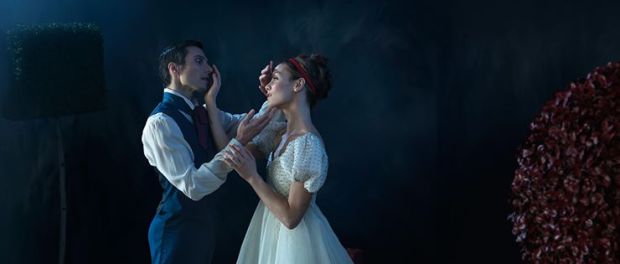An Atypical Dance Romance : Leonce and Lena Review
How often does one go to the ballet to laugh?
Seriously laugh, I mean. Not titter or politely chuckle.
Christian Spuck’s choreography of George Buchner’s comic political satire Leonce and Lena (first penned in 1838) is hilarious. The comedy starts in the first scene, when the king’s ministers create clouds of white dust each time they pat their overly formal wigs.
The story takes place on the eve of a wedding in which existentially bored Prince Leonce is prodded from his malaise to go on an adventure by his new roguish friend Valerio. The two head to an inn, where Prince Leonce meets and falls for the woman he is destined to marry anyway, Lena, who also suffers from similar existential grief.
Everything about the production is delightful and playful. The story is charming, the dancing riveting, the orchestration well-chosen, and the costumes and sets spot on.
It’s a lighthearted story in many ways. Two young people run away and fall in love. There’s an aged king who is losing his mind and is prodded up by his loyal ministers (sometimes literally). There’s a romance between a tall governess and a short rogue. At the same time, the ennui of the characters, the inescapable marriage, and even some of the dances and music seemed to be reminders that time is passing, that death is inevitable and there’s an absurdity to the formality that defines life. In other words, the light story still had its sharper edges that came through in subtle ways.
The dancing is wonderful, of course, as is the very clever musical arrangements of conductor Florian Ziemen. There’s plenty of musical humour in there — Harry Potter theme music, but also songs by Cole Porter, Johann Strauss, Amilcare Ponchielli, and Leo Delibes among others. The orchestra at times yields to the tinny sound of a boom box for a few songs, but otherwise swells with gusto as needed.
Just as the story is gentle, with the only real drama a result of inner turmoil, the dancing is playful and experimental. There’s classical ballet, but also Capioera, some Latin steps, and even disco. The moves are made to suit the characters, which develops them and allows this to be an inviting, warm piece. I especially loved the king’s stiff boogie moves and, as with everyone else, the attempts by Prince Leonce’s mistress to catch his attention as she shimmied and bounced around. Leonce and Lena were breathtaking together in a more classic form, but Christian Spuck knew where to break conventions too. The ensemble dances, whether of the rustic people of the inn or the classier city inhabitants of the royal lands allows just enough space for individuality without losing coordination and joyful synchronization.
I have to give notice to the costumer and set designer, Emma Ryott. The opening scrim with its giant head fit the story and the mood perfectly, somewhere between Tim Burton and Harry Potter films — eerie, gothic, but not with a heavy hand. When the scrim lifted to reveal the cast, the focus was on them, not the set, and it was easy to focus on them as a dance company without distraction. The set made use of a revolving wall that characters pushed around to change the scenes. Simple furnishings, such as square bushes or chandeliers, provided setting. It was a clever device that melded into the theme of the passage of time.
Again, and again, I was struck by how carefully the colors chosen suited the characters and how the costumes captured personality and mood. The “school master” was especially entertaining when she wore a silver party hat atop her mortarboard. Prince Leonce’s shallow mistress in her puffed sleeved dress was a spectacle.
There is much to admire and enjoy in this production. The standing ovation and cheers of bravo at the end of the production were more than merited. This is the perfect ballet for ballet-doubters. There’s nothing stuffy here, even if it’s about aristocrats. This has all the skill and wonder of classic ballet, but with a sweet story, gothy ambiance, and plenty of opportunities to enjoy.
Leonce and Lena plays at Place des Arts (175 St. Catherine W) September 25-27. 8 p.m. Click HERE for tickets and prices.











